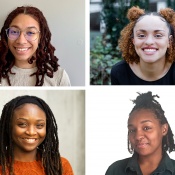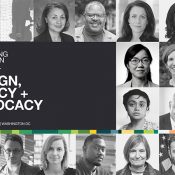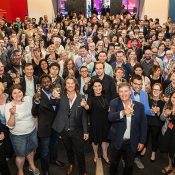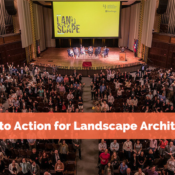Author: Barbara Deutsch
LAF Launches New BIPOC Scholarship, Internship, Mentorship Program
On January 6, the Landscape Architecture Foundation (LAF) announced LAF Ignite, a transformative new program that promises to have long-lasting impacts on the landscape architecture discipline and the communities we serve.
LAF Ignite is a comprehensive scholarship-internship-mentorship program created to help BIPOC landscape architecture students overcome barriers to staying in school, graduating, and entering practice. Student participants receive an annual $10,000 scholarship, paid summer internships, and three types of mentorships throughout their academic journey. The program is the result of a concerted, years-long effort by LAF, a dedicated group of stakeholders, and more than 100 donors to accelerate the pace and scale at which the discipline takes action to address underrepresentation of BIPOC professionals within landscape architecture.
Many barriers to becoming a landscape architect occur from the time students enter college and enter the workforce, particularly for BIPOC students who may not see themselves or their lived experience reflected in their faculty, employers, and peers. LAF Ignite was developed to support BIPOC students through this important stage – and beyond.
Countless hours went into the development and launch of this program, with extensive research, input and support from people across the profession. We had serious and often difficult conversations about race and diversity with a variety of people within the landscape architecture community. Perspectives from those with expertise and lived experience informed every aspect of the development of the program, including the idea to focus on Black/African American students for the first two years. We want to create an experience and network of support that addresses the particular needs of Black/African American students while simultaneously creating the framework to broaden the program to other students of color in the future.
The excitement around LAF Ignite has been building since we put out the call for applications last fall. Each year, 3-5 new students will be accepted into the program and participate until they have completed their landscape architecture degree. Ultimately, up to 15 students will participate in the program concurrently.
After a competitive application process, we selected the first four Ignite participants:
- Naomi Canino, Rhode Island School of Design
- Ezra Lewis, University of Georgia
- Shantol Morgan, University of Washington
- Charlye Stewart, University of Pennsylvania
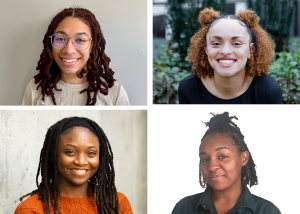
The inaugural group of LAF Ignite program participants.
These students have big ideas and hope to address important issues through landscape architecture. We were inspired by the depth, range, and scale of their interests – from mental health to food deserts to wildlife conservation – and their understanding of the important role that they as landscape architects can play in changing the world for the better.
We had so many great candidates for the Ignite program, we decided to fast-track our plans to offer finalists access to LAF’s network for mentorship and internship opportunities. The finalists are:
- Isiah Dashiell, University of Maryland
- Maurice Gaston, Illinois Institute of Technology
- Kareem Harris, University of Wisconsin
- Carington Light, North Carolina A&T State University
- Amira Slocum, North Carolina State University
LAF Ignite is a unique program within the landscape architecture community and allied professions. While each scholarship, internship, and mentorship component is important to support students, LAF Ignite’s three-component design collectively helps students overcome prevalent barriers that scholarships, internships, or mentorship cannot do alone. The multi-year scholarships are critical to help students plan and ease their financial pressures. The integrated internships and mentorship components help students build a network, explore career options, and work through challenges with a supportive group of peers and mentors.
Students and paid internship providers will be matched after a thorough interview process, based on student interests and provider needs. There are many ways to practice landscape architecture and we want students to explore different career paths, including those in the private, public, and nonprofit sectors, industry, and academia, to better meet their interests and strengthen the discipline. The internship is also an opportunity to earn money, develop skills, and build a network of professionals.
Internship providers participating in the program must demonstrate their commitment to diversity, equity, and inclusion through their policies, trainings, or initiatives. These providers also must pay a living wage to the student in the city or county where the internship takes place and provide exposure to a range of the firm or organization’s work. These requirements are key to ensure students are comfortable in the workplace and able to complete their internship successfully without the stress of low or no wages. We hope LAF Ignite sets a new standard for workplace culture.
In addition, each participant is matched with a one-on-one mentor who works with the student for the duration of their participation in the Ignite program (and hopefully beyond!). Mentors and students meet regularly (mostly virtually) based on a mutually agreed upon schedule. Students will have access to a network of subject matter experts to support specific interests as well. LAF will provide more information and begin accepting applications for mentors in the next two weeks, so subscribe to LAF’s communications or check back to our website for the announcement.
We encourage eligible students to begin thinking about the program and plan ahead for how they can be part of next year’s cohort. We also encourage anyone interested in providing an internship, mentorship, or donation to the program to visit the Ignite webpage and become part of the broad and national community of support.
The word “transformative” can be overused these days, but we project that this program will truly change and strengthen the discipline for generations to come. We are grateful for the outpouring of support from the landscape architecture community in just these past two years as LAF has worked with other organizations, developed the program, and established a baseline fund for LAF Ignite. It has been phenomenal and truly heartwarming. I am deeply honored and delighted that we are able to in turn support the talent, ideas, passion, and aspirations of the next generation to their fullest potential.
Olmsted Scholars Deliver Inspiration, Big Ideas for the Future
Every year, the Landscape Architecture Foundation (LAF) welcomes nearly 100 up-and-coming students into our LAF Olmsted Scholars Program – an initiative designed to grow and support the next generation of landscape architects. This month, we inducted 89 new Scholars from accredited college landscape architecture programs across the U.S. and Canada into the program, including two National Olmsted Scholars and six finalists. To say these Scholars are inspiring would be an understatement.
The 2022 graduate LAF National Olmsted Scholar is Katie Finnigan, from the University of Colorado Denver. Katie plans to use her $25,000 award to undertake community-engaged research on design interventions that can create acoustically and sensorially supportive outdoor environments for neurodivergent populations. It’s a topic that is important to Katie and her family, and to us at LAF.
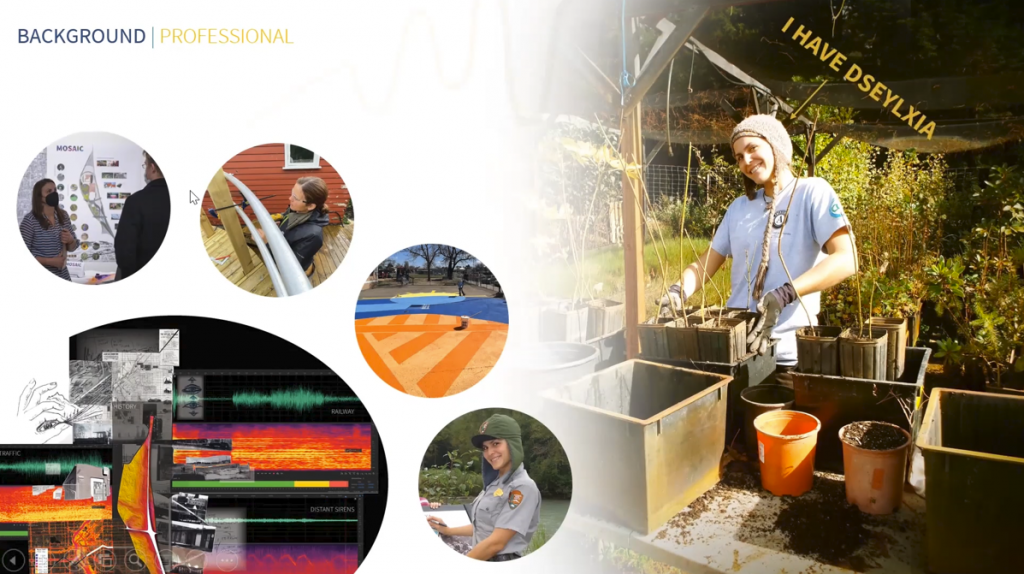
Katie Finnigan, from the University of Colorado Denver, is the Landscape Architecture Foundation’s 2022 graduate National Olmsted Scholar.
Our undergraduate winner is Trecia Cintron from The Ohio State University, who plans to use her $15,000 award to gather health histories from families in Black and Hispanic communities living adjacent to landfills and other contaminated sites along the Mississippi River. Trecia wants to create an Environmental Injustice Atlas of the Midwest – another innovative idea and far-reaching project for our communities.
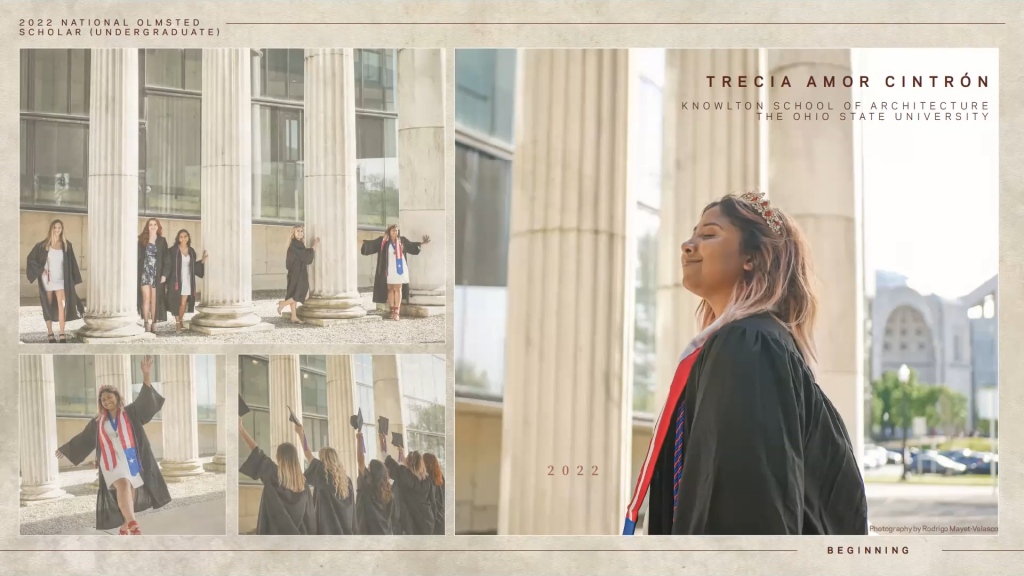
Trecia Cintron, from The Ohio State University, is the Landscape Architecture Foundation’s 2022 undergraduate National Olmsted Scholar.
Throughout our virtual Olmsted Scholars Induction Ceremony, we heard from dozens of students about impactful projects they’re working on, along with important areas of research, their motivations, and their big ideas. They want to change the world as landscape architects and they’re working on many ways and aspects of tackling climate change, social justice, and diversity, equity, and inclusion. All these goals align with what we’re doing at LAF: investing in landscape architects to create a healthier, more equitable, and sustainable world.
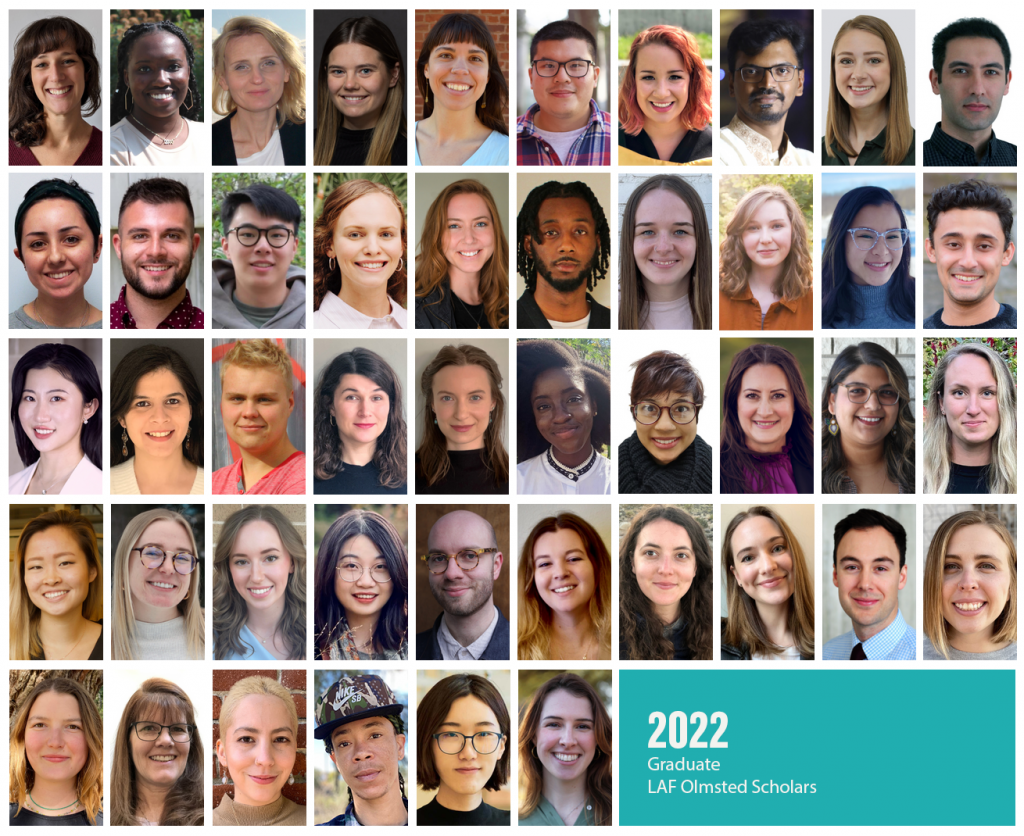
The 2022 graduate LAF Olmsted Scholars are pictured.
Among our six National Olmsted Scholar Finalists, graduate finalist Robert Douglass, from Cal Poly, Pomona, aims to put the power of design into the hands of Pomona’s youth. His goal is to help them perform ethnographic studies, photo or video documentation, interviews, or surveys on challenging areas in their community, and then connect them with designers. Our second graduate finalist, Kate Flaherty, from Cornell University, would like to compile a body of research on landscapes that have provoked and facilitated change within the larger disability rights and justice movements in the U.S., with the goal of publishing it as a written and design document to further landscape architecture and disability scholarly research. The third finalist, Daniel Kletzing, from the University of Illinois Urbana-Champaign, is working to develop relationships between our nation’s collegiate landscape architecture programs and Native American organizations to facilitate an exchange of indigenous environmental and technical expertise. The graduate finalists each received a $5,000 award.
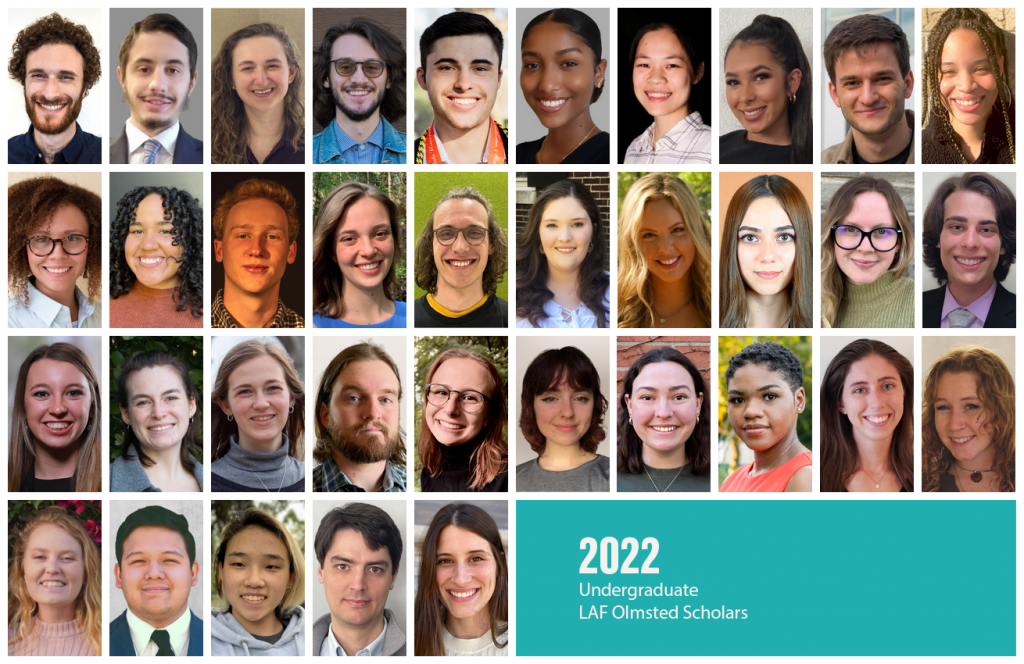
The 2022 undergraduate LAF Olmsted Scholars are pictured.
At the undergraduate level, finalist Megan Adams, from Iowa State University, is looking to better understand the correlation between therapeutic design and outcomes of social and economic improvement for students with Asperger’s Syndrome in order to advocate for people who are neurodivergent and, ultimately, design for everyone. Undergraduate finalist Avery Haynes, from Louisiana State University, aims to understand the role design plays in feelings of belonging by skateboarding through and filming designed and undesigned spaces. The third undergraduate finalist, Leigh Muldrow, from the University of Delaware, is looking to empower populations living with air, soil, and water pollution by making geolocated toxin data available to all. The undergraduates each received a $3,000 award.
More than 980 students have been named Olmsted Scholars since LAF started the program 15 years ago, including the 50 graduate students and 39 undergraduates in this year’s cohort. Next year we’ll have over 1,000 Olmsted Scholars! That’s 1,000 rising leaders shaping the world in a way that aligns with our mission and vision here at LAF.
It’s hard to put into words the excitement and inspiration I felt as I listened to our 2022 cohort talk about their projects, ideas, and inspirations. They recognize the ways innovation and sustainable design solutions can impact the world, and they want to be a part of it. In the words of graduate Olmsted Scholar Steven Shuttle, from the University of Guelph: “I envision a not-too-distant future in which we lead with landscape.” I certainly do, too. I envision a world in which our leaders call on landscape architects to help design projects – big and small – early in the planning process, and when developing policy. I envision a world with green infrastructure and equitable design. I envision a world where we can use the skills of landscape architects to their greatest potential to create a happy, healthy, and prosperous planet.
Reflecting on this year’s group of Olmsted Scholars, I feel optimistic about the future. It’s great to know these Scholars represent the next generation of landscape architects, a generation that is going to shape the world in a responsible, sustainable way. We’re in good hands! Moving forward, and I can assure you that LAF will continue to do everything we can to support and grow future generations of landscape architects.
If you’re interested in learning more about LAF’s Olmsted Scholars Program, or in watching a recording of our 2022 Induction Ceremony, visit: https://www.lafoundation.org/news/2022/08/osp-induction
Grounding the Green New Deal Summit
Following from LAF’s 2016 Summit on Landscape Architecture and the Future and the resulting New Landscape Declaration and call to action, the Landscape Architecture Foundation (LAF) is delighted to share that the next LAF summit is finally here!
More than two years in the making, the summit will be a unique conversation with transformative leaders about the role of designers and how to advocate for and implement the ideas of jobs, justice, and decarbonization in the Green New Deal. The summit continues the excitement, hope, and momentum generated from the Green New Deal Superstudio.
We are very excited to hear from the all-star lineup as they explore how to bridge the gap between policy ideas and on-the-ground reality to re-envision and re-build our future. Please plan to join us for this unique and defining conversation for the discipline!
Tickets are still available to attend in person. A selection of work from the Superstudio will be on display during the event, and the summit will end with a celebratory reception. In-person attendees can earn 4.5 PDH (LA CES/HSW) or 4.5 LU|HSW (AIA CES).
For those unable to join us in Washington, DC, LAF has just announced a livestream option which you can register to access for free. CEUs are not available for the livestream.
Grounding the Green New Deal: A Summit on Design, Policy, and Advocacy
Saturday, April 9, 12-5pm
National Building Museum, Washington, DC
There is an essential role for the built environment disciplines in addressing the climate crisis. Through panel discussions with leading changemakers like Bryan Lee Jr, Kate Orff, Colette Pichon Battle, Nikil Saval, Mitchell Silver, and Anne Whiston Spirn, this summit examines the intersection of policy, design, and advocacy to identify ways to accelerate action.
www.lafoundation.org/GNDsummit
The summit is being presented in partnership with the National Building Museum as part of its Climate Action Weekend and Climate ABC (Action/Building/Community) program series.
The Grounding the Green New Deal Summit and Superstudio are an initiative of the Landscape Architecture Foundation (LAF) in association with the Weitzman School of Design McHarg Center, the Center for Resilient Cities and Landscapes, the American Society of Landscape Architects (ASLA), and the Council of Educators in Landscape Architecture (CELA).
An Open Letter to Graduating Landscape Architecture Students
Dear graduating landscape architecture student,
I am thinking of you all as you graduate—Congratulations and well done!
You have spent a lot of time and money the last several years to get your degree. You have worked hard and are entering a noble and fulfilling profession, one that can provide a good life for you. I made a career change to become a landscape architect, and I have never looked back. I have traveled and lived in ways beyond my wildest dreams. I experience my world and those around me in a more enriching way than I ever could have imagined because of my training and work as a landscape architect. This is there for you too.
You are also entering the workplace in an epic time of uncertainty from the COVID-19 pandemic. Now the really hard work begins. No doubt you are anxious about finding a job and overwhelmed with the current economic outlook and state of the world. I can’t say that everything will work out the way you thought it would or want it to and that it will not be hard, but I do want to leave you with a few thoughts from my own experience to give you encouragement and perspective to persist and pursue your dreams of being a landscape architect and making a difference in people’s lives for the better. So please remember:
You are uniquely trained and talented as designers.
- Engineers design with concrete, architects with “bricks and mortar”, landscape architects with land, soil, water, and plants.
- We are all systems thinkers but landscape architects uniquely design for landscape systems—for natural processes, natural resources, and people; for both natural and cultural systems.
- We create the surroundings and views that connect people to each other and to nature and we design habitat for other living species.
- We design at all different scales: from the backyard, to the neighborhood, city, region, and globe.
Now more than ever, the world needs what landscape architects have to offer.
We are human beings and humans need to connect with each other and be outside. Landscape architects need to show our value in a way that others are open to receiving what we have to offer because no matter how you define sustainability—zero carbon, zero waste, biodiversity, livability—you cannot achieve it without considering landscape solutions.
- Use SITES to help you design to achieve sustainability.
- Use the One Planet Principles as your benchmarks and guide to develop projects within our fair share of resources.
- Use the LAF Landscape Performance Series for precedents and to help you show the value of sustainable landscape solutions to a wide variety of decision-makers and increase your value to an employer with this approach.
There are many ways to practice.
- Traditional private practice provides an invaluable foundation to a profession that takes a lifetime to master, but be open to look at other sectors to practice in as well.
- Federal agency landscape architects influence and impact millions of acres of land, millions of people’s lives, and billions of dollars in contracts.
- Municipal agency planners and designers influence the places we live, work, rest, and play and need your unique training to ensure a robust landscape framework that adapts to climate change, is fair and equitable for all, and ensures the health, safety and well-being of all citizens and communities.
- Environmental non-profit organizations have traction from the backyard to Capitol Hill and look for holistic problem-solving and spatial talent to translate and give form to policy ideas, programs, and projects. Check out idealist.org and look for different position titles such as “program manager”, “advocate”, “community outreach and engagement”, “analyst”, or “planner”. It may not be design in the traditional sense, but the work may be educational and rewarding for you at this time.
- When looking at a multi-disciplinary firm, be careful to understand their vision and value for landscape architecture and your role. Make sure you aren’t the only landscape architect. A multi-disciplinary firm that has landscape architects leading conceptual design for other disciplines is a tremendous opportunity.
There are many places to practice.
Look outside your home area. Work abroad. There is more than one way to do something and until I lived abroad I didn’t really understand other ways of approaching or solving a problem, or more importantly what culture was.
Don’t waste a good recession.
- Research, volunteer, keep learning— you can’t know everything you need to know with your degree. Consider earning additional certifications such as ISA certified arborist and EcoDistricts, or accreditations for SITES and Green Roof Professional (GRP), or joining networks such as SEED.
- Talk to other landscape architects and learn from informational interviews even if they do not have a job opening now. Ask them about their career path and how they got their job and what they like (and don’t like) about it. Remember you are looking for the right place for you to learn, grow, and contribute, and are interviewing them too, and things will get better at some point and may turnaround quickly so you want to be ready.
- Take other “off-path” jobs with the understanding that everything is a building block and nothing is wasted. For example:
- Brian Jencek, now Director of Planning at HOK, in this LAF webinar said when he graduated during an economic downturn he took a job working on a loading dock.
- Throughout the month of May on Fridays at 1pm ET, tune in to LAF’s Instagram Story to hear what LAF Olmsted Scholars who graduated in the aftermath of the 2008 financial crisis did to stay on track.
- Volunteer on a political campaign. It is important that people who represent our values and priorities as landscape architects are elected to office and we have valuable skills to help them: community engagement; knowledge about the environment, transportation, housing, and many other issues; and showing what their policy ideas will look like on the ground. I volunteered on a congressional campaign in between careers and learned invaluable lessons that help me to this day. It was eye-opening and fun.
Continue to nurture and sustain relationships with your graduating class and other landscape architects.
This can be done through ASLA, LAF, TCLF, and other networks. You are part of a larger group of landscape architects and a powerful critical mass. We want to learn from you. We are in this together and want you to succeed. You give us hope. You are our future. Stay in touch and stay connected.
And finally, remember this time is but one dot in the big timeline of life.
It’s a messy time, even before the pandemic. But usually things need to get messy before they get better and change happens. Just like your design process, it takes many iterations to get it right and represented in a simple and easily understandable way. For inspiration keep the New Landscape Declaration and its predecessor, the 1966 Declaration of Concern close at hand and go forth with confidence to do whatever you can to help create a new and better future, with our values and priorities leading the way.
With gratitude and best wishes,
Barbara Deutsch
CEO, Landscape Architecture Foundation
A Call to Action for Landscape Architecture
Do current events have you feeling ready to act but not sure what to do? Start by signing the Landscape Architecture Foundation’s (LAF) New Landscape Declaration.
This bold vision is a 21st century call to action for landscape architecture and serves as a potent reminder of the common values that we share.
“As landscape architects we vow to create places that serve the higher purpose of social and ecological justice for all peoples and all species. We vow to create places that nourish our deepest needs for communion with the natural world and with one another. We vow to serve the health and well-being of all communities.”
The Declaration is the synthesis of the ideas from LAF’s historic Summit on Landscape Architecture and the Future, which brought 700 landscape architects from around the world to the University of Pennsylvania in Philadelphia last June. The event was inspired by LAF’s 1966 Declaration of Concern drafted by Ian McHarg and five others who decried the burgeoning environmental crisis and heralded landscape architecture as critical to help solve it. Building on this legacy, the New Landscape Declaration asserts the critical role of landscape architecture in addressing the defining issues of our time: climate change, species extinction, rapid urbanization, and inequity.
This is a pivotal moment for the profession and a time for us all to reach beyond traditional boundaries, disciplines, and ways of thinking to have an impact. Add your signature to show your support, discuss the ideas, and send LAF your thoughts on how we — both individually and collectively — can turn the ideas into concrete actions.
By signing the Declaration, you join built environment professionals across the globe in asserting the vital role of landscape architecture and working to answer the call. Together, we can amplify our voices at this critical time when the talents and services of the landscape architecture community are so vitally needed.
To read the New Landscape Declaration and join the growing list of signatories, visit: www.lafoundation.org/declaration.

—
Barbara Deutsch, FASLA is the Executive Director of the Landscape Architecture Foundation (LAF). She brings 10 years of award-winning marketing experience from IBM before becoming a landscape architect. Prior to LAF, Barbara worked on re-greening cities from Hong Kong to DC. She served most recently as an Associate Director for BioRegional’s OnePlanet Communities program to deliver zero carbon, zero waste, livable communities.
Related on Land8: The Landscape Architecture Foundation Summit
Toward the Next 50 Years of Landscape Architecture: Will We Make Our Vital Contribution?
Fifty years ago on June 1 and 2, 1966, Ian McHarg, Grady Clay, Campbell Miller, Charles R. Hammond, George E. Patton, and John O. Simonds were convened by the newly formed Landscape Architecture Foundation (LAF) at Independence Hall in Philadelphia. Motivated by a sense of crisis about the environment and its future, they proclaimed the role of the landscape architect as critical to help solve it and drafted and signed a Declaration of Concern outlining a four-pronged strategy to multiply the effectiveness of the limited number of landscape architects and produce more trained people to cope with the future environment they foresaw.
This was the 1960s. It was a volatile time and an era of activism. It was an extraordinary time. Rivers were on fire, pesticide use was leading toward a Silent Spring — and a growing concern for the environment could no longer be ignored and avoided. The signers of the Declaration of Concern were deeply distraught with the way land was being developed and what was happening to the American landscape. In their words:
“What is merely offensive or disturbing today threatens life itself tomorrow. We are concerned over misuse of the environment and development which has lost all contact with the basic processes of nature. Lake Erie is becoming septic, New York City is short of water, the Delaware River is infused with salt, the Potomac River with sewage and silt. Air is polluted in major cities and their citizens breathe and see with difficulty. Most urban Americans are being separated from visual and physical contact with nature in any form. All too soon life in such polluted environments will be the national human experience.”
Today, as in 1966, landscape architecture has a vital role to play in the efforts to solve the complex interdisciplinary problems we face. But 50 years later, is it time to revisit the Declaration signers’ theory of change and the strategies that enable landscape architects to make their contribution?
Tools of the Time
These bold visionaries and advocates were empowered to act not only by the crisis they were confronting, but also by the political and social/cultural context of the time. The 1960s were a time of increasing environmental awareness that led to ground-breaking policies and new agencies and programs. The first Earth Day on April 22, 1970 brought out an estimated 20 million Americans at rallies and activities across the nation — 20 million people! The state of the environment was getting broad attention and support from both political parties, rich and poor, students and business people.
In late 1970, President Richard Nixon created the United States Environmental Protection Agency (EPA), and for the next decade extensive environmental legislation was passed, including the National Environmental Policy Act (NEPA, 1970), Clean Air Act (1970), Federal Water Pollution Control Act Amendments (1972), Endangered Species Act (1973), Resource Conservation and Recovery Act (1976), Clean Water Act (1977), and the Comprehensive Environmental Response, Compensation, and Liability Act (Superfund, 1980). These laws regulated emissions and toxic substances, protected wildlife, and required environmental impact statements to inform decision-making by federal agencies.
These laws were revolutionary and had a profound impact, particularly with respect to truly toxic substances. Yet, growth and development continued largely unchecked, in both the U.S. and around the world. Over time, we began to see and understand the cumulative problems of more “invisible” and pervasive pollutants like carbon emissions and stormwater runoff, and long-term landscape alterations through deforestation, sprawl, and industrialized agriculture.
 The large crowd in Fairmount Park in Philadelphia on the first Earth Day in 1970. (University of Pennsylvania Archives)
The large crowd in Fairmount Park in Philadelphia on the first Earth Day in 1970. (University of Pennsylvania Archives)
A Broader Understanding
What were seen as regional and national environmental issues 50 years ago are recognized as global issues today. As a consequence of growing populations and consumption, we face enormously complex challenges like climate change and adaptation, rapid urbanization, food insecurity, mass species extinction, and inequality. You only have to look as far as the mainstream news to see examples of water shortages in the western U.S., poor air quality in China’s megacities, inhumane living conditions in Latin American slums, and desertification in Africa to see that we are still in a state of environmental crisis.
The scale and complexity of today’s problems are massive and even more challenging given a growing societal disconnect from nature. Yet through science, we have a much deeper understanding of our environment, human health, and global systems. We understand that natural and man-made systems are completely interconnected and interdependent. We also recognize that environmental problems require solutions that weave together political, economic, and social/cultural responses, as well.
In this age of information, collaboration and technology transfer happen at a global scale and a frenetic pace, affording us an unprecedented opportunity to work together. The United Nations Framework Convention on Climate Change, Sustainable Development Goals, and upcoming Habitat III Conference on Housing and Sustainable Urban Development are examples of the ambitious visions and agendas we can create when we come together.
 17 Sustainable Development Goals were adopted as part of the adopted the United Nations 2030 Agenda for Sustainable Development. (United Nations Development Programme)
17 Sustainable Development Goals were adopted as part of the adopted the United Nations 2030 Agenda for Sustainable Development. (United Nations Development Programme)
The Role of Landscape Architecture
Despite the tremendous achievements of the last 50 years, the Declaration of Concern is remarkably and eerily still relevant today. Change a few pronouns, add a global perspective, and include climate change and its ecological, social, and economic effects, and the need for landscape architects to assert their professional expertise is even more urgent. As the Declaration states:
“There is no one-shot cure, nor single-purpose panacea, but the need for collaborative solutions. A key to solving the environmental crisis comes from the field of landscape architecture, a profession dealing with the interdependence of environmental processes.”
As landscape architects, we are uniquely trained to design for natural resources, natural processes, and people. This systems thinking and “landscape approach” give us a unique perspective and role to play in addressing the challenges of our time because no matter how sustainability is defined — zero carbon, zero waste, net zero water, biodiversity, livability — it cannot be achieved without considering landscape solutions. The world’s ambitious visions for sustainable development and climate change adaptation will need the landscape perspective and the design skills of landscape architects to operationalize these aspirations and successfully give them form.
On June 10-11, LAF is hosting an unprecedented Summit in Philadelphia to set the course for landscape architecture to make its vital contribution in the 21st century. The Summit on Landscape Architecture and the Future will bring together a diverse group of preeminent and emerging thinkers and influencers within the field of landscape architecture to critically reflect on what the profession has achieved over the last 50 years, declare bold ideas for what it should achieve in the future, and discuss how to get there.
This one-time historic convening of the profession will lay the foundation for a redrafting of the original 1966 Declaration of Concern and a landmark publication of the ideas presented. The world needs what landscape architects have to offer, and we have to get it out there in a way that others are open to receiving it. Come join us in Philadelphia to offer your voice and design leadership as we start the process of forming The New Landscape Declaration to position the profession for the next 50 years and make our vital contribution.
—
Barbara Deutsch, FASLA is the Executive Director of the Landscape Architecture Foundation (LAF). She brings 10 years of award-winning marketing experience from IBM before becoming a landscape architect. Prior to LAF, Barbara worked on re-greening cities from Hong Kong to DC. She served most recently as an Associate Director for BioRegional’s OnePlanet Communities program to deliver zero carbon, zero waste, livable communities.


